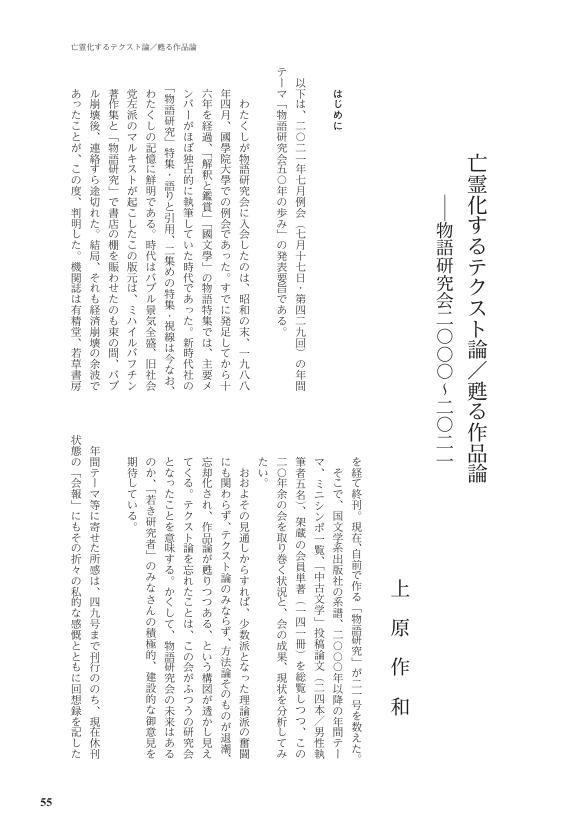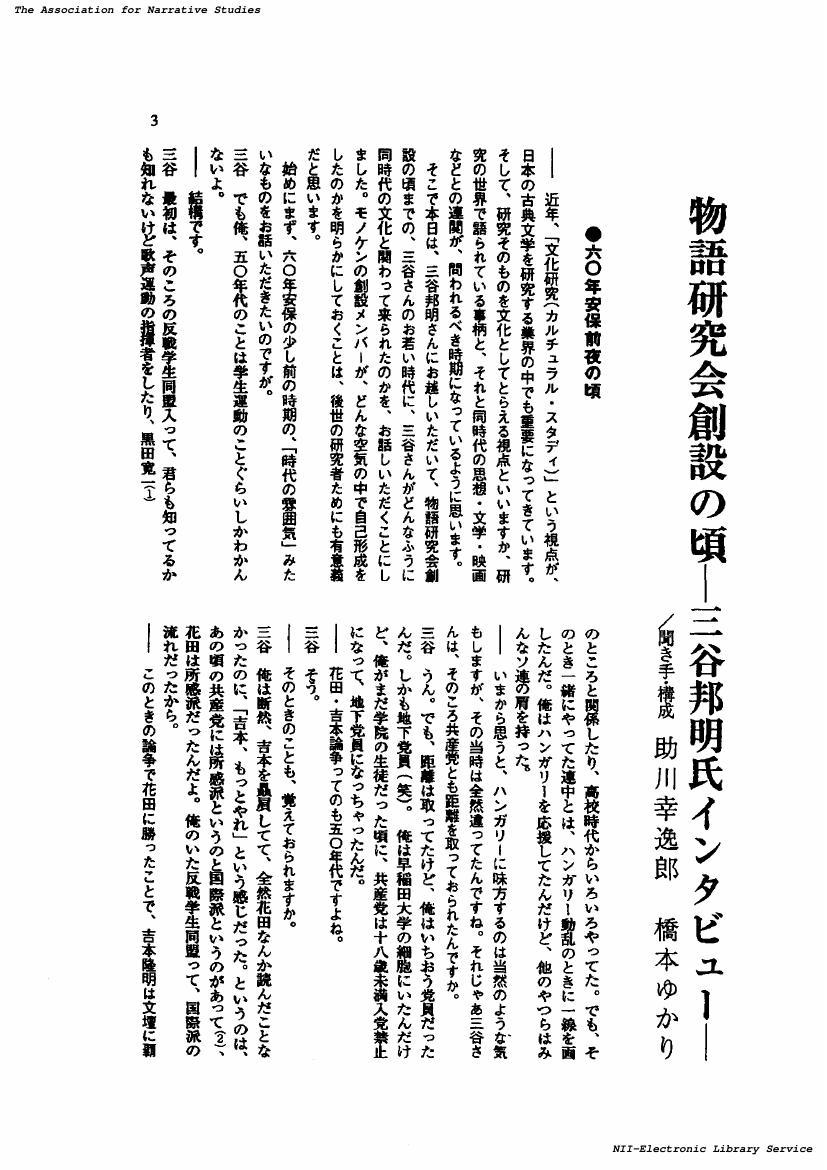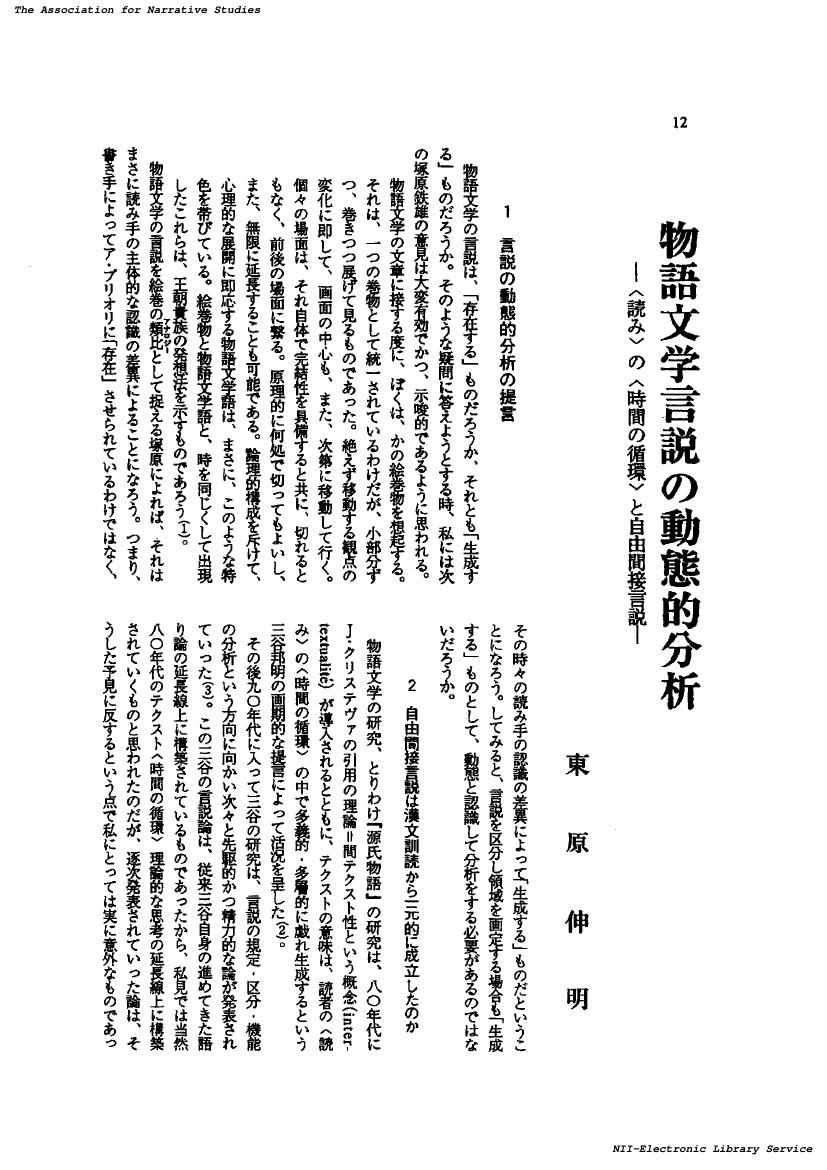39 0 0 0 OA 異人論が異人と出あうとき 動物=妖怪としての異人をアマゾニアに探る
- 著者
- 廣田 龍平
- 出版者
- 物語研究会
- 雑誌
- 物語研究 (ISSN:13481622)
- 巻号頁・発行日
- vol.22, pp.215-229, 2022-03-31 (Released:2023-04-01)
23 0 0 0 OA 足利義満の青海波 : 「中世源氏物語」の〈領域〉(<特集>年間テーマ「区分・領域」)
- 著者
- 三田村 雅子
- 出版者
- 物語研究会
- 雑誌
- 物語研究 (ISSN:13481622)
- 巻号頁・発行日
- no.1, pp.55-70, 2001-03-30
- 著者
- 原 豊二
- 出版者
- 物語研究会
- 雑誌
- 物語研究 (ISSN:13481622)
- 巻号頁・発行日
- vol.1, pp.46-54, 2001-03-30 (Released:2018-03-27)
12 0 0 0 OA 異議あり、一八世紀フランスのレトリックは転義法に「限定」されてはいない
- 著者
- ドゥエ フランソワーズ 黒木 朋興
- 出版者
- 物語研究会
- 雑誌
- 物語研究 (ISSN:13481622)
- 巻号頁・発行日
- no.8, pp.74-84, 2008-03-31
Highly influenced by Dumarsais's treatise On Tropes (1730), French rhetoric in the 18th century was "restricted" to the study of models of signification or tropes. I shall propose here four historical counter-arguments to this thesis put forward by Gerard Genette in 1970. First, in the 18th century there is no relevant break in French rhetoric since it remained unrestricted from 1598 to 1885. Second, considered a grammar by its own author and a poetics by its contemporaries, the treatise On Tropes is not in fact significantly representative of the evolution of rhetoric. Third, even in the treatises of rhetoric influenced by Dumarsais, the part assigned to tropes remained unchanged throughout the 18th century. Fourth, some other aspects of rhetoric structure reveal a considerable amount of mobility in the 18th century: action, passions, design, models of construction and styles. In brief, though stimulating in 1970, this thesis of "restricted rhetoric" has nowadays become an epistemological obstacle to the understanding of the history of rhetoric in France.
- 著者
- 柿並 良佑
- 出版者
- 物語研究会
- 雑誌
- 物語研究 (ISSN:13481622)
- 巻号頁・発行日
- vol.21, pp.153-175, 2021-03-31 (Released:2022-08-25)
- 著者
- 秋本 宏徳
- 出版者
- 物語研究会
- 雑誌
- 物語研究 (ISSN:13481622)
- 巻号頁・発行日
- vol.6, pp.206-213, 2006
4 0 0 0 OA 亡霊化するテクスト論/蘇る作品論―物語研究会二〇〇〇~二〇二一
- 著者
- 上原 作和
- 出版者
- 物語研究会
- 雑誌
- 物語研究 (ISSN:13481622)
- 巻号頁・発行日
- vol.22, pp.55-76, 2022-03-31 (Released:2023-04-01)
4 0 0 0 OA 足利義満の青海波 : 「中世源氏物語」の〈領域〉(<特集>年間テーマ「区分・領域」)
- 著者
- 三田村 雅子
- 出版者
- 物語研究会
- 雑誌
- 物語研究 (ISSN:13481622)
- 巻号頁・発行日
- vol.1, pp.55-70, 2001-03-30 (Released:2018-03-27)
4 0 0 0 OA 『土佐日記』における「パロディー」(<特集>年間テーマ「区分・領域」)
- 著者
- 佐藤 美弥子
- 出版者
- 物語研究会
- 雑誌
- 物語研究 (ISSN:13481622)
- 巻号頁・発行日
- vol.1, pp.22-32, 2001-03-30 (Released:2018-03-27)
4 0 0 0 OA 物語研究会創設の頃 : 三谷邦明氏インタビュー
- 著者
- 助川 幸逸郎 橋本 ゆかり
- 出版者
- 物語研究会
- 雑誌
- 物語研究 (ISSN:13481622)
- 巻号頁・発行日
- vol.1, pp.3-11, 2001-03-30 (Released:2018-03-27)
- 著者
- 藤井 貞和
- 出版者
- 物語研究会
- 雑誌
- 物語研究 (ISSN:13481622)
- 巻号頁・発行日
- no.8, pp.1-9, 2008-03-31
On the supposition that a linguist TOKIEDA Motoki's study of "reading" influenced the young MITANI, we would like to reflect a relationship between the study of literature and the education of national language and consider what is start of study. We would like also to analyze his doctrine that criticizes run-through readings and advocates double readings. We try to find what is the desire of readers, by mentioning the new edition of The method of "the Tale of GENJI".
4 0 0 0 OA 歌語の「形見」から物語の「形見」へ―源氏物語の「形見」前史― 杉浦和子
- 出版者
- 物語研究会
- 雑誌
- 物語研究 (ISSN:13481622)
- 巻号頁・発行日
- vol.15, pp.105, 2015 (Released:2019-04-20)
- 著者
- 武藤 那賀子
- 出版者
- 物語研究会
- 雑誌
- 物語研究 (ISSN:13481622)
- 巻号頁・発行日
- no.21, pp.2-15, 2021-03
- 著者
- 市沢 哲
- 出版者
- 物語研究会
- 雑誌
- 物語研究 (ISSN:13481622)
- 巻号頁・発行日
- vol.10, pp.84-95, 2010-03-31 (Released:2018-03-27)
Emperor Hanazono was a retired emperor at the margins. As such, he used scholarship as a tool to counter the courtiers who frequently employed the Daikakuji line and the continuation of the family for their own interests, and to justify his own position. Consequently, such scholarship was not intended to redesign the scheme that stressed the lord-vassal relationship as based on propriety (rei) and the concept of the transfer of heaven's mandate (ekisei kakumei), but it resembled "the king and the subject" (taigi meibun) concept. Moreover, Hanazono's praising of the scholarship surrounding Emperor Go-Daigo was a way for him to underscore his own superiority. Needless to say, Hanazono's learning did not exist as an independent entity but contained important political and historical aspects. The issue of fourteenth-century scholarship, especially Neo-Confucianism, has come to be viewed as a reception of Emperor Go-Daigo's political scheme and the concept of the transfer of heaven's mandate. Within this context, The Diary of Emperor Hanazono has often acted as a source for frequent reference. Previous studies have tended to de-contextualize the individual descriptions of the events and Hanazono's views on scholarship as recorded in The Diary. Finding this problematic as an approach, I argue for the importance of contextualizing these descriptions within the frame of The Diary, and propose a new reading.
3 0 0 0 OA 物語という機構の凡庸さ(物語時評)
- 著者
- 小森 潔
- 出版者
- 物語研究会
- 雑誌
- 物語研究 (ISSN:13481622)
- 巻号頁・発行日
- vol.1, pp.97-99, 2001-03-30 (Released:2018-03-27)
- 著者
- 東原 伸明
- 出版者
- 物語研究会
- 雑誌
- 物語研究 (ISSN:13481622)
- 巻号頁・発行日
- vol.1, pp.12-21, 2001-03-30 (Released:2018-03-27)
3 0 0 0 OA 緒言
- 著者
- 松岡 智之
- 出版者
- 物語研究会
- 雑誌
- 物語研究 (ISSN:13481622)
- 巻号頁・発行日
- vol.1, pp.1-2, 2001-03-30 (Released:2018-03-27)
- 著者
- 鹿島 徹
- 出版者
- 物語研究会
- 雑誌
- 物語研究 (ISSN:13481622)
- 巻号頁・発行日
- no.13, pp.24-38, 2013-03-31
As a response to the prospectus (shui-bun) of the symposium of Monogatari Kenkyukai in Summer 2012, and with regard to the recent discussion concerning methodology of historiography in Japan, this essay both tries to make the significance of procedure of historical verification clear and criticizes the positivist self-understanding of many historians. It takes up HAGITANI Boku's study of Tosa nikki as an example to show how highly specialized research of traditional Japanese literature has the potential of contributing to the discovery of traces of unrecorded existence of "forgotten ones," and makes us aware of a similar kind of people in the present society, referring to the historical theory of Walter Benjamin's "On the Concept of History." In the aforementioned situation, it isn't a narrative/story, but a Gild (image) that functions as a medium for finding out and expressing the hidden existence of these people. Furthermore, this essay considers what "stories woven in a dynamic interchange of fiction and fact" could mean in the context of the symposium prospectus. The clue is Benjamin's "The Storyteller", which analyses the flexibility and mutability of a story as a tool of communicating one's experience to others. Such a story is able to liberate us from a solid narrative framework of historiography and the novel as a modern genre of literature. With the help of Paul Ricoeur's concept "refiguration," this essay points out that every historical, fictive, and factual/fictive story might change the way of life of the storyteller as well as the listener and reader.
- 著者
- 一柳 廣孝
- 出版者
- 物語研究会
- 雑誌
- 物語研究 (ISSN:13481622)
- 巻号頁・発行日
- no.9, pp.12-19, 2009-03-31
In contemplating over how the recently established vindictive impression of "yuurei" (ghost) has changed during post-modern times, we shall attempt to heed to the notion of "shinrei" (spirit) as a medium. "Shinrei" was started to be applied in the context of spiritualism which was tinged by psychological and religious traces of the New Age during the "hanmon no jidai" (years of anguish/agony) in the mid thirty years of the Meiji Period. In respect of "reikon" (soul spirit) and "tamashii" (soul) that are deeply intertwined with the religious beliefs of the previous era, "shinrei"? was accepted as a new concept that wiped out earlier (former) images, in addition to being regarded as a key item concerning the debate over the actual existence of a "shinrei" from a scientific perspective. Thus, "shinrei" became the newly defined term in modern place. The main discourse in this study reflects over the expressions "shinrei" and "yuurei", especially employed from the late-Meiji era to the beginning of the Taisho period.
3 0 0 0 OA 逸走する<少女小説> : 『マリア様がみてる』をめぐって(物語時評)
- 著者
- 秋本 宏徳
- 出版者
- 物語研究会
- 雑誌
- 物語研究 (ISSN:13481622)
- 巻号頁・発行日
- no.6, pp.206-213, 2006-03-31














